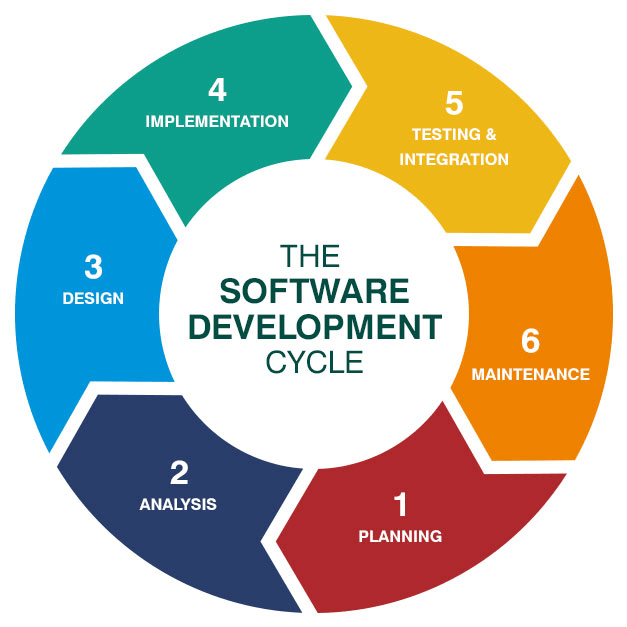6 Stages for Software Development Procedure You Need to Know


Contents
What is Software Development?
Software development is the life cycle of processes that is comprised of a well-segregated structure imposed for the development of software that might trend in the market. There are multiple processes that occur during the entirety of the software development scenario. So, if you are wondering what is software development, you need to know everything about the processes involved in the same.

The process of software development, regardless of the maker, goes through multiple stages in a stepwise fashion. It is termed as the “Software Development Lifecycle.” It is segregated into 6 various steps. The SDLC methodologies, or the Systems Development Life Cycle method supports the designing of software that meets the business requirements. A well-segregated methodology should always support the maintenance of the software for the long run.
Each phase tends to produce deliverables required to execute the upcoming step in this software life cycle. The requirements are eventually translated into perfect designs. Codes are delivered in accordance with plans which are then termed as the development phase. All these stages are concocted with the help of a team of software development technicians who are crucial for each step. No stage is conceivable without another.
Stages Involved in Software Development Procedure
1-Gathering & Analysis of Requirement:
Before the team of software technicians can cough up the general idea for any software, it is essential for the team to gather the business requirements in this very first phase. At this point, the prime focus of the stakeholders and project managers is to note the exact things needed from any software under consideration. There are several questions to be asked at this stage, which include:
- Who is supposed to use this software?
- How will the software be used upon completion?
- What type of data should be added to the software?
- What should be the data output by this software?
Once these general questions are answered, a general outline is created for the software developers to focus on. This data is then analyzed to ensure its validity & any possibility for incorporation of the same. Lastly, a document for requirement specification is prepared which serves as a guideline for the next level of the software development process.
2-Design:
This is the next phase of the software development process. In this stage, the draft design is prepared for the software from the stage-1 requirement specifications. The system designs help in specifying the hardware as well as system requirements. It also helps with the definition of an overall system in software architecture.
The design specifications for the system serve as the input for the following phase of the software development model. In this particular phase, test strategies are developed by the testers by mentioning things to test and the ways to check it.
3-Coding/Implementation:

After receiving the design documents for the software to be created, the work following the design stage is divided equally into various units and modules. This is the stage where actual coding begins. The main focus of the phase is the development of perfect codes by the developers. This particular phase is the longest in the entire protocol.
4-Testing:
If you want to know what is software development; you can never skip understanding the testing stage. This particular stage is very crucial for the developers. If anything goes wrong in the testing stage or any error is noted in the codes, it can lead to the repetition of the coding process, and the cycle goes on till the completion of the same. In this stage, all variants of functional testing such as integration testing, unit testing, system testing, acceptance testing, and non-functional testing are done.
► Read more: Offshore Software Testing Services
5-Deployment Stage:
After all the errors from coding are removed during the testing stage, the next step is termed as the deployment stage. The finalized code is implemented into the software and then deployed or delivered to the customers to be used.
As the product is being given to potential customers, the first thing done to ensure that it works fine on a large scale is to go with beta testing. If there is any possibility for changes or there are possible bugs caught during implementation, it is immediately reported to the team that engineers its errors to work fine in real-time. Once the changes are implemented with all the bugs fixed, the final dispersal or deployment is set in motion.
► Read more: Software Product Development
6-Maintenance:
Once the customers start using well-developed software, the actual issues start surfacing with time. This doesn’t mean that the software will get corrupted. However, it might require occasional issues surfacing time and again. This particular process is termed as maintenance for the finalized product or software.
SDLC Benefits
- Common technical vocabulary
- Pre-defined channels for communication between stakeholders and teams
- Clear responsibilities and roles for designers, developers, project managers, and business analysts
- Clearly-defined outputs and inputs for each step
- Deterministic step definition for confirmation of truly completed action
Software Development Process Models

The goal of software development is to locate predictable and repeatable methodologies, which help improve overall productivity as well as quality. While some try and systematize the unruly tasks for writing the software, others tend to apply the scope of software project management for the same. Without the implementation of project management, multiple things can go wrong with the same.
There are two variants of software development process models which include:
Waterfall Processes:
It is one of the oldest and best-known processes where the developers follow all the above steps in perfect order.
Benefits of Waterfall Processes
- Easy to use and understand
- Great for the small version of software
- Provides ample documentation for every phase that is crucial for future
- Important for discrete system phases
- Great for planning and management
- Well-understood milestones
- Requirement stability
Iterative Processes:
The iterative process prescribes the construction of initially small yet more significant portions of software projects to aid the ones involved. This helps uncover the issues at the initial stage, as opposed to noting the same during the final stages.
Benefits of Iterative Processes
- Better testing methods
- Useful for the determination of final system requirements
- The project control option caters to an idea of the project development stages
- Design and extension modifications can easily be made
- Useful to test systems within the development stage at the start
Conclusion
The overall time and money spent on software development vary as per requirements. For such instances, it is better to seek help from a professional software development company such as an offshore software development company that understands what they do. This helps avoid any waste of time, energy, or finances involved in the project. Hiring a novice developer to get the job done can lead to unwanted errors even after the completion of the project. This is not to say that novice developers aren’t good at what they do. However, if you have a limited budget and don’t want to take any risks, the key is to stick to professional developers.









